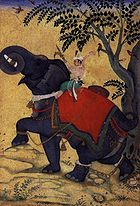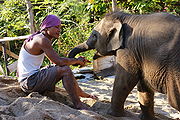
Mahout
Encyclopedia
- For the machine learning project, see Apache MahoutApache MahoutApache Mahout is an Apache project to produce free implementations of distributed or otherwise scalable machine learning algorithms on the Hadoop platform...

Asian Elephant
The Asian or Asiatic elephant is the only living species of the genus Elephas and distributed in Southeast Asia from India in the west to Borneo in the east. Three subspecies are recognized — Elephas maximus maximus from Sri Lanka, the Indian elephant or E. m. indicus from mainland Asia, and E. m....
. The word mahout comes from the Hindi
Hindi
Standard Hindi, or more precisely Modern Standard Hindi, also known as Manak Hindi , High Hindi, Nagari Hindi, and Literary Hindi, is a standardized and sanskritized register of the Hindustani language derived from the Khariboli dialect of Delhi...
words mahaut and mahavat. Usually, a mahout starts as a boy in the 'family business' when he is assigned an elephant early in its life and they would be attached to each other throughout the elephant's life.
The most common tools used by mahouts are chains and the Aṅkuśa (or ankus, anlius) –a sharp metal hook used in the training and handling of the elephant by stabbing the elephant in the head, and in areas like the mouth and inner ear, where the animal is most sensitive.
Devices used to control elephants in India
In IndiaIndia
India , officially the Republic of India , is a country in South Asia. It is the seventh-largest country by geographical area, the second-most populous country with over 1.2 billion people, and the most populous democracy in the world...
, especially Kerala
Kerala
or Keralam is an Indian state located on the Malabar coast of south-west India. It was created on 1 November 1956 by the States Reorganisation Act by combining various Malayalam speaking regions....
, mahouts use three types of device to control elephants. The thotti (hook), which is 3.5 feet in length and 3 inches thick; the valiya kol (long pole), which is 10.5 feet in length and 5.5 inches in thickness; and the cheru kol (short pole).
Use of elephants in Thailand
Deeply rooted in Thai culture, elephant training has traditionally been a familial heritage passed down through the generations. Before 1989, most domestic elephants were used for logging business and forest service to haul logs up mountains. This became illegal as widespread destruction of Thailand's forests resulted in worsening monsoons. Unlike the elephant populations of India and Africa, 95% of Thailand's elephants are domesticated working elephants and privately owned. Today most work for mahouts is in the tourist business, since elephant rides are popular among travelers to Thailand.In Thailand, tame elephants are regarded as a type of livestock and are not covered under Thailand's Conservation Act of 1992. If legally owned, there is minimal protection or welfare for them under Thai law.
The tourist experience of elephants in Thailand usually includes any combination of the following: elephant rides, trekking with elephants, elephant shows, and/or elephants begging on the streets of the big cities. Street begging elephants are used by mahouts who charge tourists to feed them. In some areas of Thailand, this practice became illegal due to the traffic dangers posed, however street begging elephants are still a common sight in Bangkok and Chiang Mai.
The Elephant Nature Park
Elephant Nature Park
Elephant Nature Park is a sanctuary and rescue centre for elephants in the Northern Thailand, Chiang Mai Province, approximately from Chiang Mai City. Founded in the 1990s, the project's aim is to provide sanctuary for distressed elephants from all over Thailand...
in Northern Thailand aims to "provide a sanctuary and rescue centre for elephants". The majority of the elephants at the park were rescued after sustaining life-threatening injuries from phajaan. Most of these elephants have permanent physical and mental injuries, including blindness, broken backs or legs, abscesses, and post traumatic stress.
Similarly, the Elephant Refuge and Education Centre (EREC) run by the Wildlife Friends Foundation Thailand, provides a refuge for elephants who have been rescued after decades of backbreaking work - formerly in the logging industry, but more recently in the tourist industry, working in camps and begging on the streets.
Terminology
Another term for mahout is cornac (as in French, from the Portuguese; kornak in Dutch and Polish, also a rather current last name). In Tamil, the word used is "pahan", which means elephant keeper, and in Sinhalese kurawanayaka ('stable master'). In Malayalam the word use is paappaan.
Thailand
Thailand , officially the Kingdom of Thailand , formerly known as Siam , is a country located at the centre of the Indochina peninsula and Southeast Asia. It is bordered to the north by Burma and Laos, to the east by Laos and Cambodia, to the south by the Gulf of Thailand and Malaysia, and to the...
kwan-chang; and in Vietnam
Vietnam
Vietnam – sometimes spelled Viet Nam , officially the Socialist Republic of Vietnam – is the easternmost country on the Indochina Peninsula in Southeast Asia. It is bordered by China to the north, Laos to the northwest, Cambodia to the southwest, and the South China Sea –...
quản tượng.
Miscellaneous
Elephants have been integral to politics and the economy in Africa and Asia. Many elephants are given away on requests of the ministers and politicians of the government, and sometimes as gifts. Elephants traditionally work for the forest service and for the logging business.In India there has been controversy over elephants attacking mahouts and villagers due to the torture some elephants endure from their mahouts, especially during Kerala festivals. More than 90% of the elephants in Kerala have been illegally obtained.
The Singapore Zoo
Singapore Zoo
The Singapore Zoo , formerly known as the Singapore Zoological Gardens and commonly known locally as the Mandai Zoo, occupies 28 hectares of land on the margins of Upper Seletar Reservoir within Singapore's heavily forested central catchment area. The zoo was built at a cost of S$9m granted by...
features a show called "elephants at work and play", where the elephants' caretakers are referred to as "mahouts", and demonstrate how elephants are used as beasts of burden in south-east Asia. The verbal commands given to the elephants by the mahouts are all in Sinhalese, one of the two official languages of Sri Lanka
Sri Lanka
Sri Lanka, officially the Democratic Socialist Republic of Sri Lanka is a country off the southern coast of the Indian subcontinent. Known until 1972 as Ceylon , Sri Lanka is an island surrounded by the Indian Ocean, the Gulf of Mannar and the Palk Strait, and lies in the vicinity of India and the...
.
In popular culture
A shop display advertising "Mahout" cigarettes features prominently in the background of the "rain dance" sequence of the famous 1952 Gene Kelly
Gene Kelly
Eugene Curran "Gene" Kelly was an American dancer, actor, singer, film director and producer, and choreographer...
film Singin' in the Rain
Singin' in the Rain
Singin' in the Rain is a 1952 American comedy musical film starring Gene Kelly, Donald O'Connor and Debbie Reynolds and directed by Gene Kelly and Stanley Donen, with Kelly also providing the choreography...
. The word "mahout" also features in the lyrics of the song "Drop the Pilot
Drop the Pilot
-Mandy Moore version:A version of the song by Mandy Moore, included as a track on her album Coverage, saw limited release as that album's second single in Brazil and the Philippines....
", by Joan Armatrading
Joan Armatrading
Joan Anita Barbara Armatrading, MBE is a British singer, songwriter and guitarist. Armatrading is a three-time Grammy Award-nominee and has been nominated twice for BRIT Awards as Best Female Artist...
.
Literature
In George OrwellGeorge Orwell
Eric Arthur Blair , better known by his pen name George Orwell, was an English author and journalist...
's Shooting an Elephant
Shooting an Elephant
"Shooting an Elephant" is an essay by George Orwell, first published in the literary magazine New Writing in the autumn of 1936 and broadcast by the BBC Home Service on 12 October 1948....
It is said that "It's [The Elephant] Mahout, is the only person who could control it.
See also
- Elephants in Kerala culture
- War elephantWar elephantA war elephant was an elephant trained and guided by humans for combat. Their main use was to charge the enemy, trampling them and breaking their ranks. A division of war elephants is known as elephantry....
, for soldiers in the mahout role, often armed and combatant - HowdahHowdahA howdah, or houdah, also known as hathi howdah, is a carriage which is positioned on the back of an elephant, or occasionally some other animal, used most often in the past to carry wealthy people or for use in hunting or warfare...
, a carriage mounted on the back of an elephant - ElefantasiaElefantasiaElefantAsia is a non-profit organisation dedicated towards the protection of the Asian elephant, Elephas maximus. This organisation operates in Laos PDR where today there are only 1500 Asian elephants remaining, 560 of these domesticated and working with their mahouts.Created by Sebastien...
, for information on mahouts living and working in LaosLaosLaos Lao: ສາທາລະນະລັດ ປະຊາທິປະໄຕ ປະຊາຊົນລາວ Sathalanalat Paxathipatai Paxaxon Lao, officially the Lao People's Democratic Republic, is a landlocked country in Southeast Asia, bordered by Burma and China to the northwest, Vietnam to the east, Cambodia to the south and Thailand to the west...

